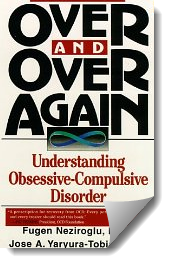 In the novel Moby Dick, Herman Melville chronicles the obsession that Captain Ahab had with a White Whale that cost him not only a leg, but in the end, his life. In their book Over and Over Again, authors Fugen Neziroglu and Jose A. Yaryura-Tobias describe obsessive-compulsive disorder as a “full-time companion.”
In the novel Moby Dick, Herman Melville chronicles the obsession that Captain Ahab had with a White Whale that cost him not only a leg, but in the end, his life. In their book Over and Over Again, authors Fugen Neziroglu and Jose A. Yaryura-Tobias describe obsessive-compulsive disorder as a “full-time companion.”
Characterized by a series of persistent thoughts and compulsions, OCD is a chronic condition fraught with suffering, shame, guilt and self-doubt. It is often incapacitating as well. The disorder typically emerges early, often in late childhood, and unfortunately for the affected individual, maintains remarkable symptom stability throughout life.
While most of us cling to certain habits and routines in our daily lives, for those with OCD, the cycle of repetition can be nothing short of hell on earth. OCD is considered ego-dystonic, in that people with the disorder want to either break or stop the patterns of obsessions and compulsions but find they are unable to do so.
Obsessions are thoughts, images or even ideas that one continues to have over and over again. Common obsessions include a fear of contamination or “germophobia,” safety concerns, a need for symmetry, a fear of evil or sinful thoughts and a constant need for reassurance.
Compulsions, by contrast, are ritualistic behaviors or mental exercises performed in response to obsessions. Ostensibly, compulsions reduce the anxiety associated with the obsessions, but this relief is merely short-lived. Common compulsive behaviors include:
- Washing and cleaning. For example, repeated washing of the hands.
- Checking. Repeated checking of door or window locks, electrical outlets or stove knobs.
- Ordering and arranging. A need for symmetry on table tops, with writing instruments or food items in the refrigerator.
- Hoarding. The ongoing collection of newspapers, magazines, clothes, canned goods.
- Mental exercises. Repeatedly counting to one self or silently stating the same phrase over and over.
The etiology of OCD has for years been controversial and remains baffling. The most salient theory to have emerged is that in OCD the frontal lobes — which normally act to inhibit the emergence of primitive urges and behaviors — fail in this inhibition, thereby igniting a breakthrough of instinctual behavioral routines outlined in the bullet points above.
As crippling as OCD can be on the person experiencing it, the effect it has on their families may be devastating. The disorder stirs family conflict, increases angst regarding how to handle or manage life with the sufferer and fuels decisions that can lead to separations and divorces.
Treatment
The pharmacological agents that offer the most promise in OCD management are the serotonin-selective antidepressants (Prozac, Luvox, Zoloft, Paxil, Celexa, Lexapro, Anafranil). The inhibitory effects of the neurochemical serotonin help to control the excessive eruption of the obsessions and compulsions that define OCD. Doses of these medications are generally 2-3 times higher than those used to treat clinical depression. At best, these medications are effective in 50 percent of OCD cases, producing a 50 to 60 percent reduction in symptoms.
The most effective strategy for treating OCD is the behavioral technique — exposure and response prevention. Exposure entails gradual and graded introduction to obsession-provoking stimuli. For example, for someone with germophobia, the exposure would have the person clean the bathtub without the use of gloves. Response prevention helps the individual avoid compulsive rituals, such as excessive hand washing after cleaning. With ERP, it is not uncommon for symptoms to get worse before they eventually improve. For patients who stick with it, this treatment modality yields up to an 85 percent positive response rate.
Success for the OCD-affected individual is best defined by the extent of symptom reduction. Eradication of symptoms is unattainable and therefore an irrational and illogical goal because we are all at least a bit OCD. With ongoing improvement, folks with OCD often develop considerable insight into the disorder. They gradually come to understand that these symptoms are a part of them and help define their uniqueness. With this in mind, they then “give themselves permission” to have the symptoms and they gradually adapt to them. OCD also improves with age thereby providing long-term hope for those afflicted by this often humiliating syndrome.
————————————————————
Joe Wegmann is a licensed clinical social worker and a clinical pharmacist with over 30 years of experience in counseling and medication treatment of depression and anxiety. Joe’s new book, www.pesi.com. To learn more about Joe’s programs or to contribute a question for Joe to answer in a future article, visit his website at www.thepharmatherapist.com, or e-mail him at joe@thepharmatherapist.com.